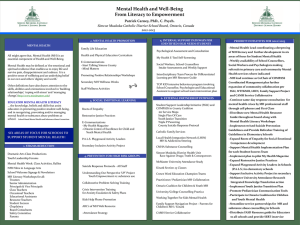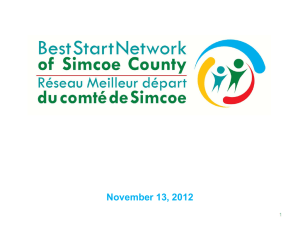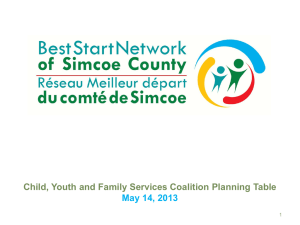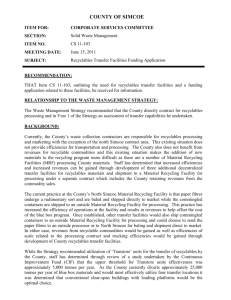Lesson Resource Kit: Travels of Elizabeth Simcoe
advertisement
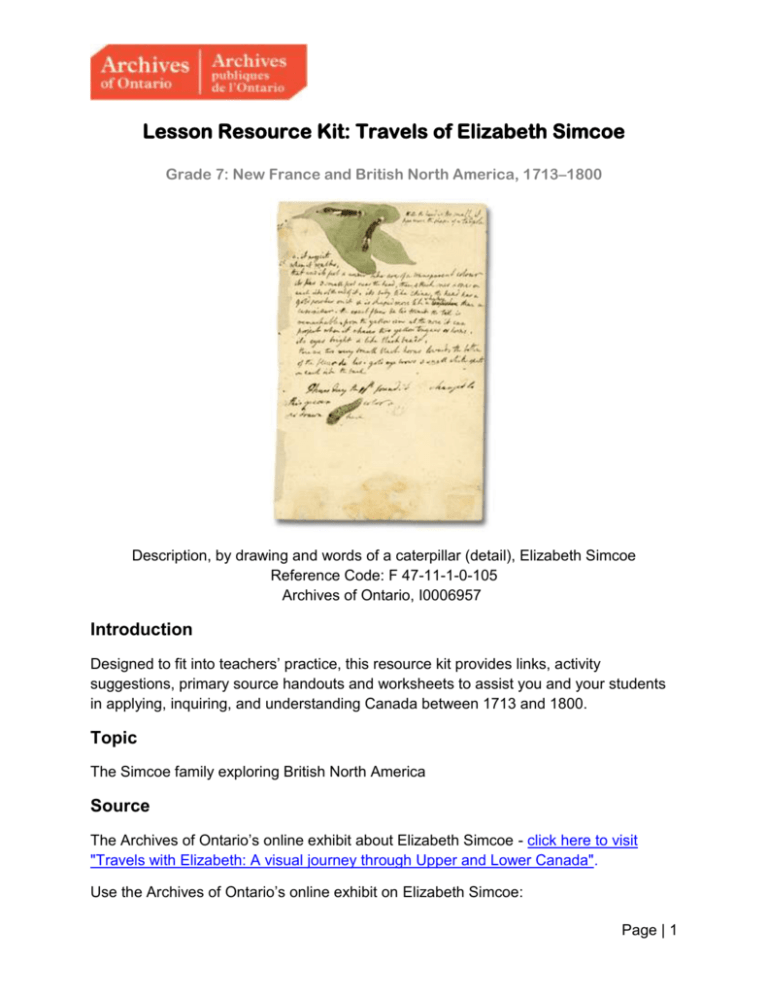
Lesson Resource Kit: Travels of Elizabeth Simcoe Grade 7: New France and British North America, 1713–1800 Description, by drawing and words of a caterpillar (detail), Elizabeth Simcoe Reference Code: F 47-11-1-0-105 Archives of Ontario, I0006957 Introduction Designed to fit into teachers’ practice, this resource kit provides links, activity suggestions, primary source handouts and worksheets to assist you and your students in applying, inquiring, and understanding Canada between 1713 and 1800. Topic The Simcoe family exploring British North America Source The Archives of Ontario’s online exhibit about Elizabeth Simcoe - click here to visit "Travels with Elizabeth: A visual journey through Upper and Lower Canada". Use the Archives of Ontario’s online exhibit on Elizabeth Simcoe: Page | 1 As a learning resource for yourself As a site to direct your students for inquiry projects As a place to find and use primary sources related to the curriculum Themes that can be addressed Using Primary Sources The landscape of eighteenth century Upper and Lower Canada The Simcoe family and their significance to Canadian history Continuity and change between colonial and present-day Canada Curriculum Strand A. New France and British North America, 1713–1800 Overall Expectations Historical Thinking Concepts Specific Expectations A1. Application: Colonial and Present-day Canada Continuity and Change; Historical Perspective A1.1, A1.2 A2. Inquiry: From New France to British North America Historical Perspective; A3. Understanding Historical Context: Events and Their Consequences Historical Significance; Historical Significance A2.1, A2.2, A2.3, A2.4, A2.5, A2.6 A3.6 Cause and Consequence Page | 2 Assignment & Activity Ideas Inquiring into the Simcoe Family The historical inquiry process involves five steps: Formulating a question Gathering and organizing information or evidence Interpreting and analysing information or evidence Evaluating information or evidence and drawing conclusions Communicating findings The curriculum highlights that these steps do not have to be completed sequentially nor together. You may wish to explore specific steps based on your students’ readiness and prior knowledge or your own resources and time. For more details, click here to see pages 22-24 in the 2013 revised Ontario Social Studies and History curriculum. Using a primary source handout from this kit, introduce your students to the Simcoes and their experiences in Upper and Lower Canada. Have students ask questions of the sources. Use these questions as jumping off points for exploring these historical issues in depth. Follow this link to use the Travels with Elizabeth: A visual journey through Upper and Lower Canada online exhibit as a source to point your students for their own inquiry project. Here, they can view primary sources and secondary information to gather and organize historical information that they can interpret, evaluate, and communicate for different end products. Creating a Primary and Secondary Source Use Creating a Primary Source worksheet to introduce your students to the idea of using primary source records to learn about the past Giving your students a text or image primary source found in this Kit, use the Creating a Secondary Source worksheet to have your students write a summary or description of the primary source. Using these two documents have a discussion about the difference between primary and secondary sources and which type of document would be the most valuable for learning history Page | 3 Life Then and Now: Similarities and Differences Have students pick one primary source diary entry and read it for comprehension. Have students rewrite the diary from a modern perspective. For example, if someone was ill now (see Elizabeth Simcoe’s Diary (April 14, 1795)) would their symptoms be the same or different? Would the treatment be the same or different? Would concern be the same of different? Use these rewritten diaries to further the discussion of differences and similarities about the past and today. Alternatively, this activity could be completed with the Officers Carriole and Canadian Carriole (1792) primary source sketch. Have students complete a similar image about two forms of present-day transportation. Alternatively, ask students to focus on the similarities and differences between today and the geographic landscapes that Simcoe created. Use the Sketches of Present-Day Canada worksheet to assist in this task. Experiences of Travel Comic Strip Using any of the Elizabeth Simcoe diary entries and the Comic Strip Cells worksheet, ask students to graphically depict the Simcoe’s experiences outlined in the diary entry. Have students complete additional research to further their understanding of colonial British North America Page | 4 Handouts & Worksheets Introduction to Primary Sources ...................................................................................... 6 Elizabeth Simcoe’s Diary (July 17, 1792) ........................................................................ 7 Elizabeth Simcoe’s Diary (July 30, 1792) ........................................................................ 8 Elizabeth Simcoe’s Diary (August 17, 1792) ................................................................... 9 Elizabeth Simcoe’s Diary (July 28, 1794) ...................................................................... 10 Elizabeth Simcoe’s Diary (October 30, 1794) ................................................................ 11 Elizabeth Simcoe’s Diary (April 14, 1795) ..................................................................... 12 The Liberty from Whitby (1791) ..................................................................................... 13 Creating a Primary Source ............................................................................................ 14 Creating a Secondary Source ....................................................................................... 15 Comic Strip Cells ........................................................................................................... 16 Officers Carriole and Canadian Carriole (1792) ............................................................ 17 View of Quebec (1791).................................................................................................. 18 Castle Frank (1796)....................................................................................................... 19 Road to the Provision Store (1792) ............................................................................... 20 Niagara Falls (1792) ...................................................................................................... 21 Navy Hall, Newark (1793) ............................................................................................. 22 Near the 40 Mile Creek (1794) ...................................................................................... 23 Sketch Map of Upper Canada (1795) ............................................................................ 24 Sketches of Present-Day Canada ................................................................................. 25 Page | 5 Introduction to Primary Sources Description, by drawing and words of a caterpillar (detail), Elizabeth Simcoe Reference Code: F 47-11-1-0-105 Archives of Ontario, I0006957 A primary source is a document or object from the past created by people who lived during that time. Primary sources provide a view into an event or experience that only people living during that time could have experienced. Archives collect and preserve primary sources so that students can learn history from the experiences of people who were there. At an archive, primary sources are called records. At a museum, primary sources are called artifacts. Have you ever used a primary source before? Primary Sources Original material from the past Example: Letters Diaries Photographs Paintings and other art work Graphs Maps Secondary Sources Material people today write about the past Example: Textbooks Reference books Websites such as Wikipedia Current news articles Documentaries Movies What are some other examples of Primary and Secondary Sources? Can sources be both Primary and Secondary? Page | 6 Elizabeth Simcoe’s Diary (July 17, 1792) “The Governor was walking on the hill this evening when his shoulder and finger were struck by a shot fired by a soldier belonging to the guard tent, who had fired at an Indian dog which had taken away some pork. A shot remained in the Governor's finger and was very painful. A gentleman walking with him was struck and the dog severely wounded. An Indian was also struck by the shot. The Governor immediately gave him the soldier's gun to appease him and reprimanded the soldier.” -Elizabeth Simcoe Excerpt from Elizabeth Simcoe’s Diary, July 17, 1792 Reference Code: F 47-8-0-1 Archives of Ontario Page | 7 Elizabeth Simcoe’s Diary (July 30, 1792) “People cross from Chippawa to Fort Schlosser (an earthwork fort on the American shore, about a mile and a half above the Falls), but great caution is necessary, the current is so extremely strong and if they did not make exactly the mouth of the Chippawa the force of the water below it would inevitably carry them down the Falls without redress. Eight soldiers, who were intoxicated, met with this accident in crossing the river some years since. Their bodies were taken up entire some distance below the Falls. An Indian was in his canoe near Fort Schlosser. The canoe was tied to a tree; some person cut the rope; he did not wake until the canoe had gotten into the strong current. He found all his endeavours to paddle ineffectual and was seen to lay himself down, resigning himself to his fate, and was soon carried down the falls.” -Elizabeth Simcoe Excerpt from Elizabeth Simcoe’s Diary, July 30, 1792 Reference Code: F 47-8-0-1 Archives of Ontario Page | 8 Elizabeth Simcoe’s Diary (August 17, 1792) “We were so cold and wet we were glad to drink tea. It was quite dark and too windy to allow of our burning candles . . . I wrapped myself up in two or three greatcoats and intended, if the tent was blown down, to take shelter under the great dinner table. The rain and wind did not cease for two hours, and we had no means of drying our clothes and were obliged to sleep in a wet tent. However, we have not caught cold.” -Elizabeth Simcoe Excerpt from Elizabeth Simcoe’s Diary, August 17, 1792 Reference Code: F 47-8-0-1 Archives of Ontario Page | 9 Elizabeth Simcoe’s Diary (July 28, 1794) “We rose at six and left for the Forty-Mile Creek. We walked through the village and beyond Green's Mills a little way up the mountain . . . Green [a Loyalist from New Jersey who had settled in the area around 1788 and accompanied Simcoe on many of his trips) ground the corn for all the military posts in Upper Canada. His mill stood five miles east of Hamilton on the Stoney Creek Road. A mile further is a mill and a small waterfall, and at a season when the water is higher the scenery must be wonderfully fine. I drank tea at Green's and unwillingly left this fine scenery. Mrs. Green advised me to give Francis crow's foot boiled in milk until it becomes red and thick, which she said would cure the present complaint in his stomach. There are 100 people settled at the Forty, and there have been but seven graves in five years. The Governor promises that I shall ride on the mountain above the Forty this season.” -Elizabeth Simcoe Excerpt from Elizabeth Simcoe’s Diary, July 28, 1794 Reference Code: F 47-8-0-1 Archives of Ontario Page | 10 Elizabeth Simcoe’s Diary (October 30, 1794) “We have received from Montreal a birch bark canoe such as is used by the North-West Company to transport their goods to the Grand Portage. It requires 12 men to Paddle is large enough to contain four or five Passengers to sit very commodiously in the centre under an awning. An Indian woman came to-day with Pitch, which is made by the Indians from Fir Trees, to gum the Canoe if any part of it is worn off by bringing it hither. She held a piece of pitch in her hand, and melted it by applying a piece of burning wood. Her figure was perfectly wild & witchlike & a little fire with a kettle on it by her side, in a stormy dark day, the waves roaring on the beach near which she stood formed a scene very wildly picturesque.” -Elizabeth Simcoe Excerpt from Elizabeth Simcoe’s Diary, October 30, 1794 Reference Code: F 47-8-0-1 Archives of Ontario Page | 11 Elizabeth Simcoe’s Diary (April 14, 1795) “The Governor has been so ill since the 21st of March that I have not left his room since that day. He has had such a cough that some nights he could not lie down, but sat in a chair, total loss of appetite and such headaches that he could not bear any person but me to walk across the room or speak out loud. There was no medical advice but that of a horse doctor who pretended to be an apothecary. The Governor, out of consideration for the convenience of the staff-surgeon, had allowed him to remain at Niagara, and his not being made to attend his duty has caused me a great deal of anxiety to see the Governor so ill without having proper attendance. Capt. Brant's sister prescribed a root it is, I believe, calamus, a genus of palm, one species of which yields a resin called dragon's blood, the root of which is the sweet flag, which really relieved his cough in a very short time.” -Elizabeth Simcoe Excerpt from Elizabeth Simcoe’s Diary, April 14, 1795 Reference Code: F 47-8-0-1 Archives of Ontario Page | 12 The Liberty from Whitby (1791) Nov 2nd, 1791 - The Liberty from Whitby, Elizabeth Simcoe, (1766-1850) Reference Code: F 47-11-1-0-6 Archives of Ontario, I0006857 “I quite enjoy the thoughts of the long journey we have before us, & the perpetual change of scene it will afford.” - March 15, 1792 “Wind N.W., cold, hard gale. This hard gale did not cool the cabins, which had been so extremely heated. I was, therefore, glad to be on deck to get rid of my headache, notwithstanding the weather was so rough that I was obliged to hold fast by a cannon. The waves, rising like mountains, have the grandest and most terrific appearance, and when the ship dashes with violence into the sea, much as a chaise in the act of overturning, it is surprising she rights again. I viewed this tempestuous scene with much astonishment. ” –Oct. 15, 1791 Excerpts from Elizabeth Simcoe’s Diary Reference Code: F 47-8-0-1 Archives of Ontario Page | 13 Creating a Primary Source Elizabeth Simcoe wrote and sketched in her diary to record new and different experiences. We now can use her diary and sketches to understand what Canada looked like in the 1790s. We call these diaries and sketches Primary Sources because they are original records for learning about the past. Use this worksheet to write a diary entry and sketch a picture of a new experience that you have had. How can this record be a primary source in the future? Page | 14 Creating a Secondary Source Secondary sources are documents people today write about the past. Using a primary source - an original document created by someone living in the past about their own experience – describe in your own words what the person in the past experienced in the space below: Questions to think about: Have you left out any details to make your summary fit on the page better? Did you have any questions that the primary source didn’t answer? Page | 15 Comic Strip Title:__________________________________________________________________ By:___________________________________________________________________ Blank comic strip frame Blank comic strip frame Blank comic strip frame Blank comic strip frame Blank comic strip frame Blank Blank comic strip frame strip frame Page | 16 Officers Carriole and Canadian Carriole (1792) Officers Carriole (prettier and perpetually over setting); Canadian carriole (safe and pleasant), ca. 1792 Elizabeth Simcoe, (1766-1850) Reference Code: F 47-11-1-0-18 Archives of Ontario, I0006870 View of Quebec (1791) View of Quebec, Lower and Upper towns, from the River, ca. 1791 Elizabeth Simcoe, (1766-1850) Reference Code: F 47-11-1-0-14 Archives of Ontario, I0006866 Castle Frank (1796) Castle Frank, 1796 Elizabeth Simcoe, (1766-1850) Reference Code: F 47-11-1-0-231 Archives of Ontario, I0006538 Road to the Provision Store (1792) Road to the Provision Store, officer going his rounds Quebec, February 26, 1792 Elizabeth Simcoe, (1766-1850) Reference Code: F 47-11-1-0-26 Archives of Ontario, I0006878 Niagara Falls (1792) Niagara Falls, Ontario, July 30, 1792 Elizabeth Simcoe, (1766-1850) Watercolour paper Reference Code: F 47-11-1-0-71 Archives of Ontario, I0006923 Navy Hall, Newark (1793) Navy Hall, the part is the canvas house, The fort at Niagara, A large arbor in the Hill, Toronto Shore, ca. 1793 Elizabeth Simcoe, (1766-1850) Reference Code: F 47-11-1-0-99 Archives of Ontario, I0006951 Near the 40 Mile Creek (1794) Near the 40 Mile Creek L. Ontario, ca. 1794 Elizabeth Simcoe, (1766-1850) Reference Code: F 47-11-1-0-121 Archives of Ontario, I0006973 The town of Grimsby was founded in 1790 and was originally named “The Forty,” after a group of United Empire Loyalists who settled at the mouth of 40 Mile Creek. Sketch Map of Upper Canada (1795) Map of Upper Canada showing the routes the Simcoes took on journeys between March 1793 and September 1795, Simcoe family fonds Reference Code: F 47-5-1-0-37 Archives of Ontario, I000475 Sketches of Present-Day Canada Elizabeth made many sketches of places that are around today. Pick one of Elizabeth’s Simcoe’s sketches and find a photograph of what that places looks like today. Make a sketch or watercolour painting in a similar style to Elizabeth’s to show similarities and differences of the landscape today and in the past.
